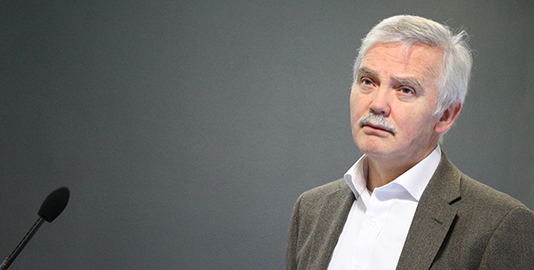The Basis for Wage Settlements in 2014
Historisk arkiv
Publisert under: Regjeringen Solberg
Utgiver: Arbeids- og sosialdepartementet
Preliminary Report
Pressemelding | Dato: 19.02.2014
The Basis for Wage Settlements in 2014. Preliminary Report from the Norwegian Technical Calculation Committee for Wage Settlements.

Ådne Cappelen, Committee chairman. Photo: ASD
Press release from the Norwegian Technical Calculation Committee for Wage Settlements:
The Basis for Wage Settlements in 2014. Preliminary Report
The report outlines recent years’ developments in pay, incomes, prices, macroeconomic development and competitiveness. The Committee also presents a forecast of consumer price growth from 2013 to 2014 and briefly describes prospects for the international economy and the Norwegian economy. The report is based partly on preliminary statistics and estimates for 2013. Parts of the report will therefore be updated in March, and will include figures for pay by gender and education.
Summary of main findings
The Calculation Committee estimates average pay growth from 2012 to 2013 for wage earners as a whole to 3.9 per cent. Differences in pay growth between the major bargaining areas[1] varied between 3 per cent for health trust employees and 6.7 per cent for employees in financial services. Wage growth for workers in manufacturing in firms affiliated to NHO[2] is estimated to 3½ per cent, and wage growth for all employees in manufacturing firms affiliated to NHO[3] is estimated to approximately 4 per cent.
The wage carry-over into 2014 is estimated to an average of ¾ per cent for employees in the main bargaining areas1. The estimates vary from a ½ per cent for local government employees to 1½ per cent for non-manual manufacturing employees in firms affiliated to NHO.
Average real after-tax pay for wage earners increased by 1.8 per cent from 2012 to 2013 compared to 3.2 per cent the previous year. Lower growth in real after-tax pay is primarily due to higher consumer price growth in 2013 than in 2012. The real after-tax pay growth rate is a little below the average growth rate for manufacturing workers and somewhat higher than the average for employees in financial services.
The Committee forecasts an average consumer price growth of about 2.5 per cent from 2013 to 2014. The actual figure for 2013 was 2.1 per cent. The uncertainty in the inflation forecast for 2014 relates chiefly to krone exchange rate, which sometimes fluctuates widely through the year; but developments in energy prices are also uncertain.
The Calculation Committee presents a number of quantified indicators to describe Norwegian business and industry’s international competitive position. Several of these components, in particular cost indicators, suggest a weakened situation for Norwegian firms in recent years. This picture contrasts somewhat with the figures for employment and actual production output in Norway compared with other countries. While some economic indicators show that Norway is doing better than many other economies, the high cost level makes future competitiveness uncertain for firms in parts of the economy.
In the Norwegian model for wage settlements (Frontfagsmodellen), the manufacturing industry’s competitiveness is secured by a system of wage bargaining that ensures a stable distribution of value added between capital owners and wage earners. Wage costs as share of gross factor income in Norwegian manufacturing industry, has fluctuated moderately with the business cycle around a relatively steady level. For 2013, the wage cost share was estimated to have been nearly 4 per cent higher than the average wage cost share in the last ten years.
Cost competitiveness in the manufacturing industry, measured exclusively by relative hourly wage costs in a common currency, has deteriorated over the past years due to higher growth in wage costs in Norway than in trade partner countries and due to appreciation of the krone. However, in 2013 a krone depreciation reduced the comparative wage costs by 0,2 per cent.
Average hourly wage costs in manufacturing in Norway in 2013 were an estimated 55 per cent higher than a trade-weighted average of our EU trading partners, measured in a common currency. This is 2 percentage points less than in 2012.
The committee observes that estimates of GDP-growth in the Norwegian economy for 2014 from various forecasters suggest growth below trend growth. Unemployment is estimated to remain constant or increase moderately.
Table 1. Annual pay growth from 2011 to 2012 and from 2012 to 2013 and wage carry-over into 2014 in some bargaining areas
|
|
Pay growth from 2011 to 2012 in per cent |
Pay growth from 2012 to 2013 in per cent |
Wage carry-over into 2014 in per cent |
|
All employees in the manufacturing industry at firms affiliated to NHO1 |
4.2 |
4 |
- |
|
Manual manufacturing employees |
4.1 |
3½ |
1¼ |
|
Non-manual manufacturing employees at firms affiliated to NHO1 |
4.2 |
4¼ |
1½ |
|
Employees at firms affiliated to Virke2, retail trade |
3.3 |
4.0 |
1.0 |
|
Employees in financial services |
3.0 |
6.7 |
1.0 |
|
Central government employees |
4.1 |
- |
- |
|
Local government employees |
4.1 |
3½ |
½ |
|
Employees at firms affiliated to Spekter3, excluding health trusts |
4.2 |
3½ |
¾ |
|
Health trust employees |
3.7 |
3 |
¾ |
- Confederation of Norwegian Enterprise
- The Enterprise Federation of Norway
- An employers’ association.
Contact
Contact person for further information:
Committee chairman Ådne Cappelen, Statistics Norway (Statistisk sentralbyrå), tel. + 47 488 82 950 or e-mail: adne.cappelen@ssb.no